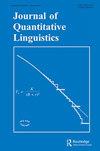Analysis of Transitional Areas in Dialectology: Approach with Fuzzy Logic
IF 1.7
2区 文学
0 LANGUAGE & LINGUISTICS
引用次数: 0
Abstract
ABSTRACT Comparing the dialectal classifications into disjointed zones with the representation of populations in a geolectal continuum has emphasized the importance of transition regions. Identifying these regions has been the subject of study in the scientific literature, although research has not been conducted in a reliable manner. Based on the Basque ‘Bourciez’ Corpus, we have highlighted the limitations of dialectal classifications using deterministic methods along with the possibilities provided by fuzzy logic. By contributing objectivity to the analysis, the C-means classification has allowed us to retain information from the deterministic classification, identify transition regions, emphasize the geolectal continuum and minimize the artificial isolation of certain populations in the classification. Classifying the French-Basque territory into two groups has separated the populations into two nearly-disjointed dialectal zones. Classifications into three and four groups have underscored the broad overlap between adjacent linguistic zones. This paper’s contribution has provided a new explanatory dimension and consequently improves the linguistic interpretation. In this sense, the results are in accordance with the previous contributions described in the literature and have justified the integration of different viewpoints.方言过渡区分析:模糊逻辑的方法
摘要将方言分类为不相交区域与地理连续统中的人口表示进行比较,强调了过渡区域的重要性。确定这些区域一直是科学文献研究的主题,尽管研究尚未以可靠的方式进行。基于巴斯克语的布尔西兹语料库,我们强调了使用确定性方法进行方言分类的局限性以及模糊逻辑提供的可能性。通过为分析提供客观性,C均值分类使我们能够保留确定性分类的信息,识别过渡区域,强调地理连续性,并最大限度地减少分类中某些群体的人为隔离。将法属巴斯克地区分为两组,将人口分为两个几乎不相交的方言区。将其分为三组和四组,突显了相邻语言区域之间的广泛重叠。本文的贡献提供了一个新的解释维度,从而改进了语言学解释。从这个意义上说,这些结果与文献中描述的先前贡献一致,并证明了不同观点的整合是合理的。
本文章由计算机程序翻译,如有差异,请以英文原文为准。
求助全文
约1分钟内获得全文
求助全文
来源期刊

Journal of Quantitative Linguistics
Multiple-
CiteScore
2.90
自引率
7.10%
发文量
7
期刊介绍:
The Journal of Quantitative Linguistics is an international forum for the publication and discussion of research on the quantitative characteristics of language and text in an exact mathematical form. This approach, which is of growing interest, opens up important and exciting theoretical perspectives, as well as solutions for a wide range of practical problems such as machine learning or statistical parsing, by introducing into linguistics the methods and models of advanced scientific disciplines such as the natural sciences, economics, and psychology.
 求助内容:
求助内容: 应助结果提醒方式:
应助结果提醒方式:


